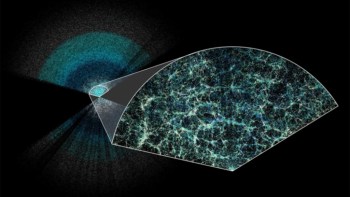
Insights into dark energy and the expansion of the universe could come from an earthbound experiment involving ultracold atoms. That’s the claim of a team of physicists in the US and UK led by the Nobel laureate Martin Perl, which plans to drop caesium atoms through 1.5 m along two atom interferometers. Any “dark sector” forces on the atoms will result in a phase difference that the team hopes to measure by comparing results from the two devices.
Dark energy is the name given to the mysterious substance that is believed to be causing the expansion of the universe to accelerate by exerting a negative pressure that opposes the pull of gravity. But although dark energy appears to account for about 75% of the energy-mass content of the universe, scientists have no real idea what it is. Most attempts at understanding dark energy involve observations of distant supernovae and the cosmic microwave background.
But Perl and colleagues believe that we can glean new insights into dark energy from an atom-interferometer experiment performed in a laboratory here on Earth. The team hopes to detect any hitherto unknown “dark content of the vacuum” (DCV), which, they argue, could behave like dark energy on cosmological time and distance scales. The experiment, which is described in a paper on the arXiv preprint server, should be up and running by 2014.
Different space/time paths
According to Perl’s blueprint, each interferometer works by dropping a bunch of atoms through a 1.5 m tall vacuum chamber. A laser pulse is then fired at the bunch at the top of the chamber, putting each atom into a superposition of two quantum states. A second laser pulse would then be used to recombine the atoms at the bottom and then the interference between the two paths is measured to reveal the phase shift between states that accumulates during the fall.
The researchers plan to run the experiment using two identical interferometers, which will allow them to cancel out the effect of the Earth’s gravitational field. In the absence of any DCV, the phase shifts measured by each device would be the same. However, if the DCV density is different at each interferometer, the phase shifts would be different.
“We are now building the apparatus and expect to have one interferometer operating within two years and the full double spectrometer operating after three years,” Perl told physicsworld.com. “The major experimental problems are the reduction of noise from sources such as mechanical vibration and drifts in photonic components,” said Perl who is professor emeritus at the SLAC National Accelerator Laboratory in California.
According to the team, detection is based on two assumptions. The first is that the DCV exerts a force on matter – and that the force is not gravitational in nature. The second assumption is that the DCV field has a non-uniform spatial distribution. In other words, atoms in the two different interferometers would experience slightly different forces, leading to a small shift in the relative phase of the atoms – which would show up in the interference pattern.
Difficult to connect to dark energy
However, this second assumption contradicts the cosmological-constant model of dark energy, which describes dark energy as a property of empty space that is the same everywhere in the universe.
Indeed, if the experiment does detect hitherto unknown forces, it could be difficult to compare the results to other dark-energy measurements. “Most other dark energy searches (like microwave background analyses) are looking for dark energy on cosmological scales of time and space, whereas we are interested in dark energy density fluctuations on terrestrial scales, here and now,” says Holger Mueller of the University of California, Berkeley who collaborated with Perl on the design of the experiment. “Cosmology does not tell us what to expect on those scales.”
As a result, some cosmologists are sceptical about the experiment’s ability to tell us something about dark energy. “Atom interferometers are an exciting technological advance that will be an important tool in fundamental physics investigations,” says Eric Linder, who is also at Berkeley but is not involved in the work. “However, [cosmologists] have no expectation that they will reveal the cause of cosmic acceleration.”
Robert Caldwell, a cosmologist at Dartmouth College in New Hampshire, told physicsworld.com that would be “fantastic” if Perl’s team discovers some new phenomena in the laboratory. However, he warns that “it may be a hard sell to make the connection a posteriori to dark energy”.
The experiment is described in arXiv: 1101.5626.



